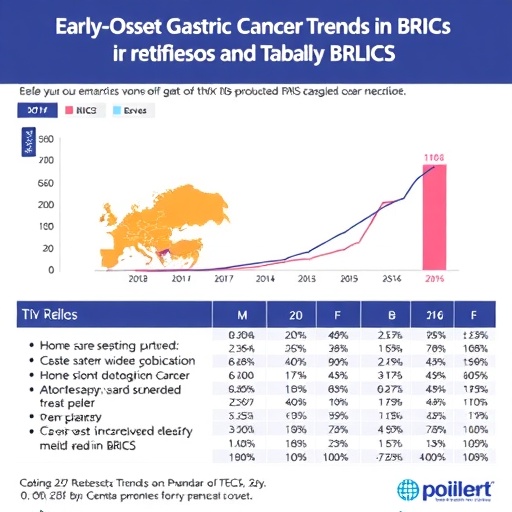Although they look less like cigarettes than first-generation e-cigarettes, a new study found that the newer generation e-cigarette vape pens (also known as vaporizers) stimulate the urge to smoke as powerfully as watching someone smoke a "combustible" tobacco cigarette.
The study, published Jan. 12, 2017, in Nicotine & Tobacco Research, found that young adult smokers exposed to the use of traditional cigarettes, first-generation e-cigarettes or second generation vape pens experienced an immediate, significant and lasting increase in the desire to smoke. This extended even to subjects who had never used the newer devices.
"The new e-cigarettes, known as vape pens, are now larger and more powerful devices," said study director Andrea King, PhD, professor of psychiatry and behavioral neuroscience and director of the clinical addictions research laboratory at the University of Chicago. "They have low resemblance to cigarettes, so some people were hoping they might not produce the same urge to smoke."
"But we found that they do stimulate the urge," she said. "Vape pens look different but they share too many salient features of the act of smoking — including inhalation, exhalation and hand-to-mouth behaviors. This makes them a potent trigger, encouraging people to smoke. Their impact is roughly equal to watching someone light up a cigarette. They made the young adults in our study want to smoke."
E-cigarettes entered the U.S. market in 2007. Vape pens, a second-generation electronic nicotine-delivery system (ENDS), are more recent. Despite initial hopes that e-cigarettes, and now vape pens, could help smokers break away from tobacco, studies have not been able definitively to confirm that they contribute to smoking cessation efforts.
In 2015, the U.S. Centers for Disease Control's National Health Interview Survey (NHIS) found that about one in six current cigarette smokers (15.9%) and nearly one in four recent (past year) former cigarette smokers (22%) were regular e-cigarette users, compared with 2.3 percent of long-term former cigarette smokers and 0.4 percent of never smokers. According to the survey, e-cigarette use is "strongly associated with the use of other tobacco products among youth and young adults, including combustible tobacco products."
King and colleagues designed an experiment to test the vape pen's effects on the urge to smoke in young adults, men and women aged 18 to 35, a highly susceptible group.
They recruited volunteers though online advertisements for a study they described as "assessing mood response to commons tasks." They were able to enroll 108 volunteers. These ranged from very light to pack-a-day smokers. On average, they smoked 8.7 cigarettes a day on six to seven days each week. More than 80 percent had used e-cigarettes and almost 30 percent had used one in the past month.
Over an hour-long session — involving a number of disparate tasks and interactions designed to mask the primary goals of the study — the volunteers conversed with a member of the research team who pretended to be a fellow volunteer "randomly assigned" to consume different products as study tasks.
During these interactions, the pretending volunteer smoked either a combustible cigarette or a vape pen. Both cues increased desire among research subjects for a cigarette or an e-cigarette. The level and duration of desire to smoke among volunteers was the same whether they observed their "colleague" smoking a cigarette or using a vape pen. When the colleague drank bottled water, volunteers had no change in desire to smoke or vape.
Late in the study, the researchers added a behavioral component to measure the ability of 26 of the daily smokers to resist or postpone smoking about twenty minutes after they were exposed to their partners' vaping or smoking. At this time, one cigarette was placed on a tray, along with a lighter and an ash tray. Volunteers were told they could smoke the cigarette, or receive 20 cents for every five minute they resisted, a $2.00 value over 50 minutes. Most could hold out for only 20 minutes (80 cents worth), and this delay was the same whether their partner had been previously using a vape pen or a cigarette.
"We've made real progress on reducing smoking in our country," King said. "We've done a good job banning indoor smoking. We rarely see two-pack-a-day smokers like we used to. Yet seeing people smoke in public remains common. Our study focused on a classical Pavlovian trigger, as seeing someone smoke is a known potent cue that can induce others to smoke. We did not expect that the vape pen would be as potent a cue as the regular cigarette, but it was as potent."
"The regulations in the U.S. on when and where somebody can use an e-cigarette are not yet standard," she added. "But we do know that, so far, the use of e-cigarettes has not had a major direct impact on smoking cessation efforts above and beyond public health messages and taxes. The sight of someone using a vape pen bumps up the urge to smoke, so this may play a role in dual use of cigarettes and e-cigarettes, but future studies are needed."
Strengths of the study included a wide range of smoking levels, a controlled environment, ethnic and racial diversity, and the ability to gather the desired data without tipping their hand. Only 20 percent of the study volunteers were able to guess correctly about the goals of the study. Weaknesses included a relatively small sample size, reliance on a laboratory environment and the inability to rearrange the order of the smoking-related cues presented to the subjects.
###
Additional authors were Lia J. Smith, Patrick J. McNamara, Dingcai Cao from the University of Chicago. The National Institutes of Health and the University of Chicago Department of Psychiatry funded the study.
Media Contact
John Easton
[email protected]
773-795-5225
@UChicagoMed
http://www.uchospitals.edu
############
Story Source: Materials provided by Scienmag




